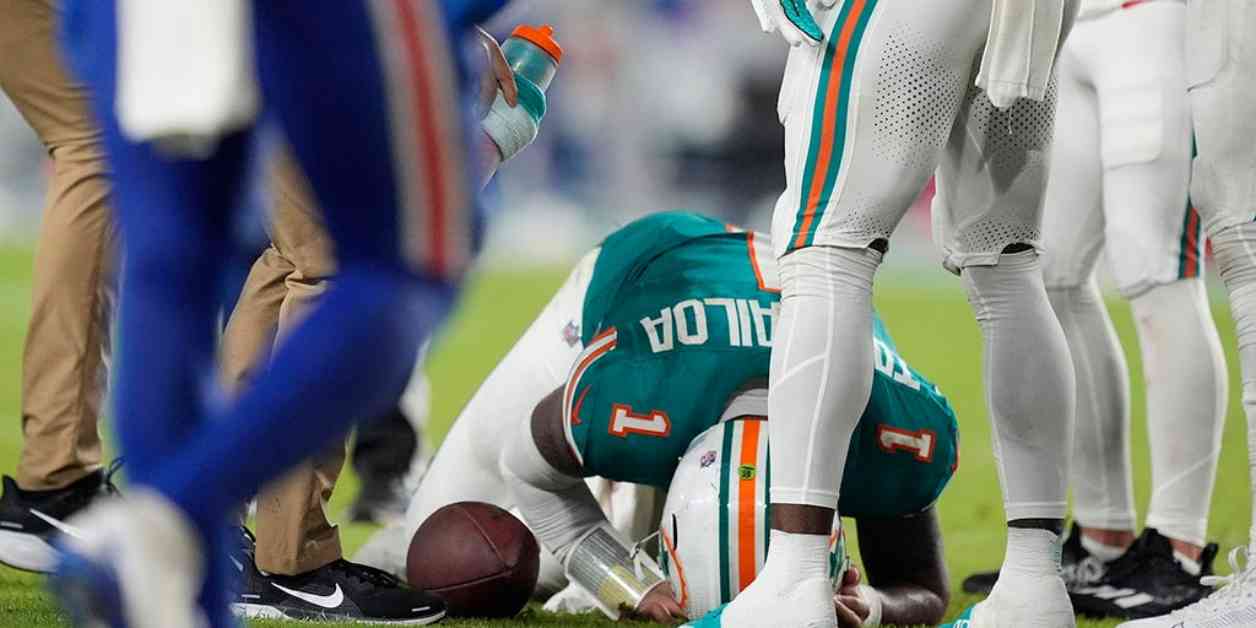Miami Dolphins quarterback Tua Tagovailoa faced a frightening moment during a recent Thursday Night Football game against the Buffalo Bills, as he suffered a concussion following a collision with Bills safety Damar Hamlin. The incident occurred on a crucial 4th-and-4 play, with the Dolphins needing a touchdown to stay in the game. Tagovailoa took off running to get past the first-down line and keep the drive alive. Despite passing the line, he continued running and encountered Hamlin in the open field. Unfortunately, instead of sliding or avoiding contact, Tagovailoa led with his head, resulting in a hard collision that left him disoriented and in need of immediate medical attention.
The Dolphins medical staff wasted no time in assessing Tagovailoa’s condition, determining within six minutes of him leaving the field that he had indeed suffered a concussion. After the collision, Tagovailoa was seen limping and holding his head as he walked off the field with trainers and into the locker room for further evaluation. This latest concussion adds to a series of head injuries that Tagovailoa has endured throughout his career, raising concerns about his long-term health and well-being.
History of Head Injuries
Tagovailoa’s struggles with concussions date back to the 2022 season, where he suffered three concussions, including one on a Thursday Night Football game against the Cincinnati Bengals that resulted in him being carted off the field on a stretcher. Despite these setbacks, Tagovailoa managed to play through the 2023 season without missing a game. However, the lingering effects of these head injuries have continued to haunt him, with the recent concussion against the Bills marking another concerning chapter in his injury-plagued career.
In a previous game against the Bills, Tagovailoa appeared to suffer a concussion but was initially diagnosed with a back injury. This misdiagnosis highlights the challenges and complexities of identifying and treating head injuries in professional sports. The repeated blows to the head have taken a toll on Tagovailoa’s health and well-being, raising questions about the NFL’s protocols for handling concussions and player safety.
Impact on Tagovailoa’s Career
The recurring concussions have not only affected Tagovailoa’s physical health but also his mental and emotional well-being. In a recent interview, the Hawaii native admitted to considering retirement at one point due to the potential long-term consequences of head injuries, including chronic traumatic encephalopathy (CTE). The fear of permanent damage and cognitive decline weighed heavily on Tagovailoa’s mind, prompting him to reevaluate his future in the NFL.
Despite these challenges, Tagovailoa remained resilient and determined to continue playing the sport he loves. His commitment to the game and his teammates was evident in his efforts to return to the field following each concussion. However, the toll that these injuries have taken on his body and mind cannot be ignored, raising concerns about his long-term health and ability to sustain a successful career in professional football.
League Response and Player Safety
The NFL’s handling of concussions and player safety has come under scrutiny in recent years, with critics questioning the effectiveness of the league’s protocols and guidelines for managing head injuries. The emphasis on player safety and the long-term health of athletes has become a pressing issue in professional sports, prompting calls for stricter regulations and better medical oversight.
In response to the growing concerns about concussions and head injuries, the NFL has implemented various initiatives to improve player safety and reduce the risk of long-term damage. These efforts include enhanced concussion protocols, increased medical supervision, and better education for players and coaches on the signs and symptoms of head injuries. However, the recent incident involving Tagovailoa highlights the ongoing challenges and complexities of addressing concussions in a contact sport like football.
As Tagovailoa continues to recover from his latest concussion, the focus remains on his health and well-being, as well as the broader implications for player safety in the NFL. The need for greater awareness and vigilance when it comes to head injuries is paramount, as the long-term consequences of concussions can have lasting effects on athletes’ lives and careers. It is essential for the league, teams, and players to work together to prioritize player safety and ensure that proper measures are in place to protect against head injuries and their potential consequences. The future of players like Tagovailoa depends on a collective effort to address the risks and challenges associated with head injuries in professional sports.




